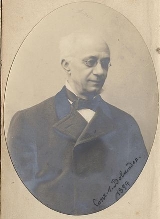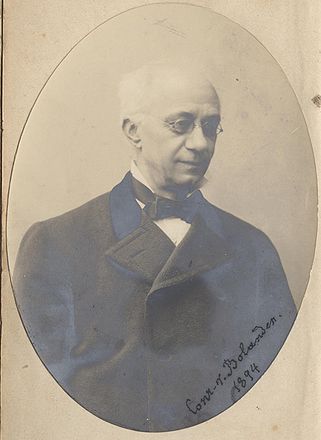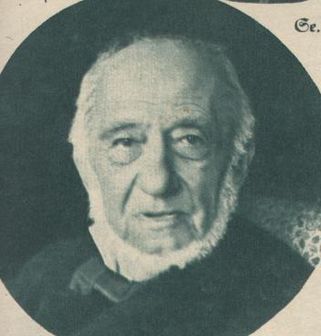
Conrad von Bolanden
Encyclopedia


A German novelist, son of a rich merchant, b. 9 August, 1828, at Niedergailbach
Niedergailbach
Niedergailbach is a small village in the German state of Saarland. In 2000 it had 581 inhabitants. Located on the border with France, it is adjacent to the French village of Obergailbach.-External links:* http://www.niedergailbach.com/index2.htm...
, a village of the Palatinate (region), in that time a part of Bavaria
Bavaria
Bavaria, formally the Free State of Bavaria is a state of Germany, located in the southeast of Germany. With an area of , it is the largest state by area, forming almost 20% of the total land area of Germany...
. Now Niedergailbach
Niedergailbach
Niedergailbach is a small village in the German state of Saarland. In 2000 it had 581 inhabitants. Located on the border with France, it is adjacent to the French village of Obergailbach.-External links:* http://www.niedergailbach.com/index2.htm...
belongs to the Saarland
Saarland
Saarland is one of the sixteen states of Germany. The capital is Saarbrücken. It has an area of 2570 km² and 1,045,000 inhabitants. In both area and population, it is the smallest state in Germany other than the city-states...
, although the main portion of the Palatinate (region) became a part of the neighbour-state Rheinland-Pfalz. Bolanden attended the Latin school at Blieskastel
Blieskastel
Blieskastel is a municipality in the Saarpfalz district, in Saarland, Germany. It is situated on the river Blies, approximately 8 km west of Zweibrücken, and 20 km east of Saarbrücken.-International relations:...
, the seminary at Speyer
Speyer
Speyer is a city of Rhineland-Palatinate, Germany with approximately 50,000 inhabitants. Located beside the river Rhine, Speyer is 25 km south of Ludwigshafen and Mannheim. Founded by the Romans, it is one of Germany's oldest cities...
, and in 1849 entered the University of Munich
Munich
Munich The city's motto is "" . Before 2006, it was "Weltstadt mit Herz" . Its native name, , is derived from the Old High German Munichen, meaning "by the monks' place". The city's name derives from the monks of the Benedictine order who founded the city; hence the monk depicted on the city's coat...
to study theology. Ordained priest in Speyer
Speyer
Speyer is a city of Rhineland-Palatinate, Germany with approximately 50,000 inhabitants. Located beside the river Rhine, Speyer is 25 km south of Ludwigshafen and Mannheim. Founded by the Romans, it is one of Germany's oldest cities...
1852 he was appointed assistant pastor at the cathedral (Speyer Cathedral
Speyer Cathedral
The Speyer Cathedral, officially the Imperial Cathedral Basilica of the Assumption and St Stephen, in Latin: Domus sanctae Mariae Spirae in Speyer, Germany, is the seat of the Roman Catholic Bishop of Speyer and is suffragan to the Archdiocese of Bamberg. The cathedral, which is dedicated to St...
). Two years later he became pastor at Kirchheim-Bolanden. The following year he was transferred to Börrstadt
Börrstadt
Börrstadt is a municipality in the Donnersbergkreis district, in Rhineland-Palatinate, Germany....
and three years later to Berghausen
Berghausen
Berghausen is the name of several communes:* Berghausen, Austria, a municipality in Styria, Austria* Berghausen, Rhineland-Palatinate - a municipality in the Verbandsgemeinde Katzenelnbogen, district Rhein-Lahn, Germany...
. During this time he wrote his first four works: "A Wedding Trip" (about Martin Luther
Martin Luther
Martin Luther was a German priest, professor of theology and iconic figure of the Protestant Reformation. He strongly disputed the claim that freedom from God's punishment for sin could be purchased with money. He confronted indulgence salesman Johann Tetzel with his Ninety-Five Theses in 1517...
), "Queen Bertha " (Bertha of Savoy
Bertha of Savoy
Bertha of Savoy , also called Bertha of Turin, was the first wife of Emperor Henry IV, and was German Queen and Holy Roman Empress. She is buried in the cathedral of Speyer.-Life:...
), "Historical Tales of Frederick II."(Frederick II of Prussia
Frederick II of Prussia
Frederick II was a King in Prussia and a King of Prussia from the Hohenzollern dynasty. In his role as a prince-elector of the Holy Roman Empire, he was also Elector of Brandenburg. He was in personal union the sovereign prince of the Principality of Neuchâtel...
) and "Gustav Adolf" (Gustavus Adolphus of Sweden
Gustavus Adolphus of Sweden
Gustav II Adolf has been widely known in English by his Latinized name Gustavus Adolphus Magnus and variously in historical writings also as Gustavus, or Gustavus the Great, or Gustav Adolph the Great,...
). From the castle and village of Bolanden
Bolanden
Bolanden is a municipality in the Donnersbergkreis district, in Rhineland-Palatinate, Germany....
(between Kirchheim-Bolanden and Börrstadt) he chose his pen name "Conrad von Bolanden". In 1870 the priest resigned his parish to devote himself exclusively to literary work, and lived in strict retirement at Speyer. He published more than 60 books, mostly novels, of which the most noteworthy are:
"Canossa
Canossa
Canossa is a comune and castle town in Emilia-Romagna, famous as the site where Holy Roman Emperor Henry IV did penance in 1077, standing three days bare-headed in the snow, in order to reverse his excommunication by Pope Gregory VII...
", "Franz von Sickingen
Franz von Sickingen
Franz von Sickingen was a German knight, one of the most notable figures of the first period of the Reformation.-Biography:He was born at Ebernburg near Bad Kreuznach...
" "Trowel or Cross", "Night of St. Bartholomew" (St. Bartholomew's Day massacre
St. Bartholomew's Day massacre
The St. Bartholomew's Day massacre in 1572 was a targeted group of assassinations, followed by a wave of Roman Catholic mob violence, both directed against the Huguenots , during the French Wars of Religion...
), "Savonarola", "Crusades", "Wambold", "Charlemagne
Charlemagne
Charlemagne was King of the Franks from 768 and Emperor of the Romans from 800 to his death in 814. He expanded the Frankish kingdom into an empire that incorporated much of Western and Central Europe. During his reign, he conquered Italy and was crowned by Pope Leo III on 25 December 800...
", "Otto the Great" (Otto I, Holy Roman Emperor
Otto I, Holy Roman Emperor
Otto I the Great , son of Henry I the Fowler and Matilda of Ringelheim, was Duke of Saxony, King of Germany, King of Italy, and "the first of the Germans to be called the emperor of Italy" according to Arnulf of Milan...
), "Pillar of Truth". His novels and romances, though not all of equal worth, are written for the people, brilliant in conception, simple in style. He fearlessly defends the Catholic standpoint and supports his position by frequent quotations from original sources. His works were widely read and have been translated into English and almost 6 further languages. Some time his publications were prohibited in the Kingdom of Prussia
Prussia
Prussia was a German kingdom and historic state originating out of the Duchy of Prussia and the Margraviate of Brandenburg. For centuries, the House of Hohenzollern ruled Prussia, successfully expanding its size by way of an unusually well-organized and effective army. Prussia shaped the history...
. By Pope Pius IX
Pope Pius IX
Blessed Pope Pius IX , born Giovanni Maria Mastai-Ferretti, was the longest-reigning elected Pope in the history of the Catholic Church, serving from 16 June 1846 until his death, a period of nearly 32 years. During his pontificate, he convened the First Vatican Council in 1869, which decreed papal...
he was honored with the title of a Papal Chamberlain (Papal Gentlemen
Papal Gentlemen
The Papal Gentlemen, also called the Gentlemen of His Holiness, are the lay attendants of the pope and his papal household in Vatican City. They serve in the Apostolic Palace near St. Peter's Basilica...
). Bolanden was the first priest of the Diocese of Speyer
Speyer Cathedral
The Speyer Cathedral, officially the Imperial Cathedral Basilica of the Assumption and St Stephen, in Latin: Domus sanctae Mariae Spirae in Speyer, Germany, is the seat of the Roman Catholic Bishop of Speyer and is suffragan to the Archdiocese of Bamberg. The cathedral, which is dedicated to St...
, who had a driver license. In his birth-village Niedergailbach
Niedergailbach
Niedergailbach is a small village in the German state of Saarland. In 2000 it had 581 inhabitants. Located on the border with France, it is adjacent to the French village of Obergailbach.-External links:* http://www.niedergailbach.com/index2.htm...
a street is named according him, since 1993.
External links
- Catholic Encyclopedia Article
- German Wikipedia article with rich picture-stuff

